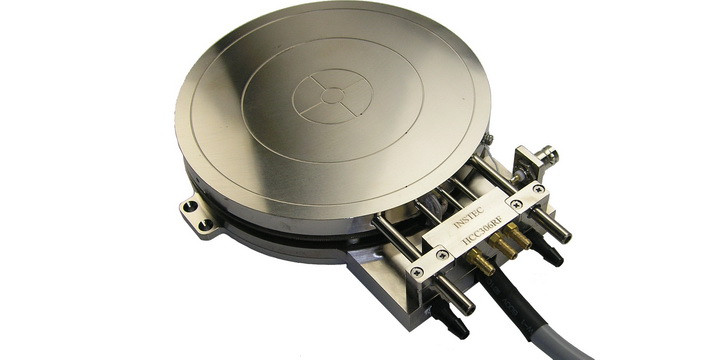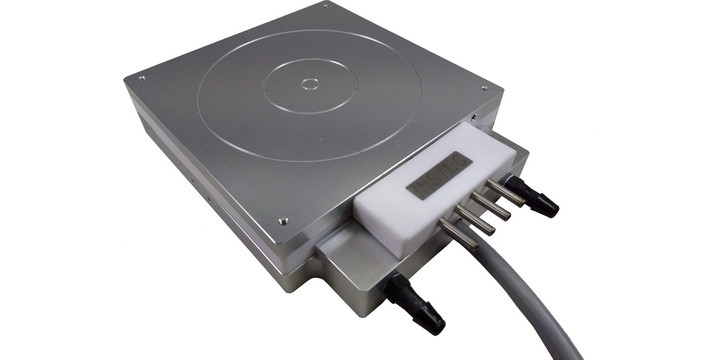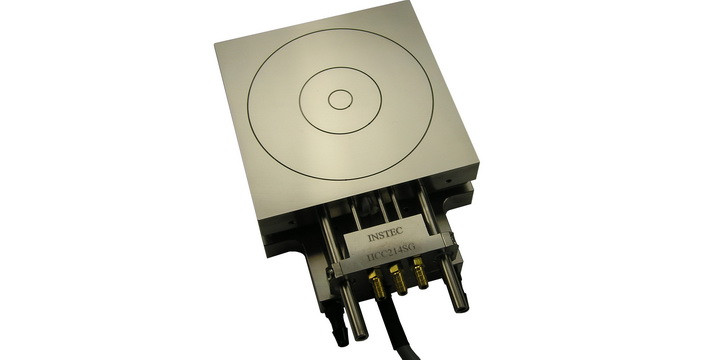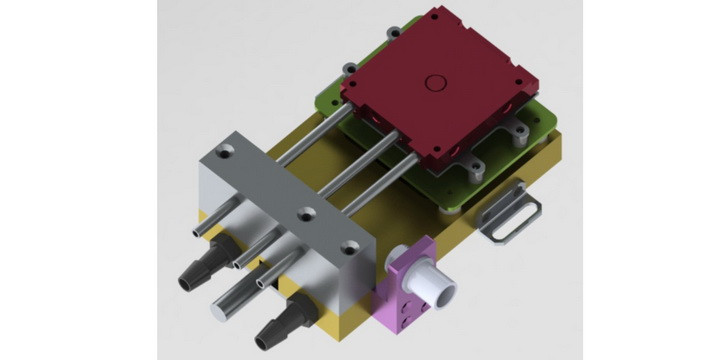Thermal chuck 시스템은 반도체 웨이퍼 및 디바이스의 프로빙, 특성 분석, 검사 및 고장 분석에 필수적입니다. INSTEC은 수십 년에 걸친 온도컨트롤 전문 지식을 업계 최고의 thermal chuck으로 기여했습니다. 옵션으로 직경 20mm ~ 300mm 또는 정사각형 표준 샘플링 영역 (600mm customization)이 가능합니다. 독립적인 동심 표면 진공 그로브 (concentric surface vacuum grove)로 샘플을 고정합니다. -190ºC ~ 600ºC (최대 1500ºC customization)의 정밀한 온도조절로써, ±0.1ºC의 온도 균일성 (temperature uniformity)과 안정성이 함께 제공됩니다. 접지 (grounded), coaxial (floating) 및 triaxial (guarded) chuck surface 옵션은 다양한 응용 분야에서 최고의 electrical control을 제공합니다. 옵션인 triaxial heater는 electrical noise의 감소에 도움이 됩니다.
|
Series |
||||
|
Type |
Round thermal wafer chucks |
Square shape |
Square sample area |
Small footprint |
|
Design |
웨이퍼 테스트용으로 설계되었습니다. |
액체질소를 사용하지 않는 열전 가열 / 냉각 (thermoelectric heating and cooling) |
다른 실험 워크스페이스와 잘 어울립니다. |
샘플크기: 3mm ~50mm |
|
Noise |
Grounded (R), floating (RF), or triaxial (RT) surface optioss |
S (grounded), SF (floating), or ST (triaxial) options |
S (grounded), SF (floating), or ST (triaxial) options |
Optional floating surfaces. Silver surfaces |
|
Vacuum |
다양한 크기의 웨이퍼를 위한 multi vacuum zone |
다양한 크기의 웨이퍼를 위한 multi vacuum zone |
다양한 크기의 웨이퍼를 위한 multi vacuum zone |
|
|
Sample size |
45mm x 150mm, |
12mm x 50mm, |
8mm x 50mm, |
Sample sizes: 3mm up to 50mm |
|
Temperature range |
-100°C ~ 300°C* |
-30°C ~ 120°C |
-120°C ~ 600°C* |
-190°C ~ 600°C |
|
Cooling |
Optional cooling down to -100°C |
Cooling down to -30°C without using LN2 |
Optional cooling down to -120°C |
|
|
Noise |
Optional triaxial for pA current measurements |
Optional triaxial for pA current measurements |
Optional triaxial for pA current measurements |
|
|
Software |
온도-시간 데이터를 기록하는 PC소프트웨어 제공 |
온도-시간 데이터를 기록하는 PC소프트웨어 제공 |
온도-시간 데이터를 기록하는 PC소프트웨어 제공 |
온도-시간 데이터를 기록하는 PC소프트웨어 제공 |
"*" Depending on models
FEATURES
THERMAL BLOCK

- The heart of all electrical probe systems, stages, chucks, and thermal plates is a thermal block or sample plate for heating and cooling
- Built from aluminum, silver, or ceramic depending on the intended temperature range
- Embedded with heating elements and liquid nitrogen cooling channels as well as temperature sensors to provide the most precise thermal control for the sample
SAMPLING AREA
- The sample area of the heating block is the effective area over which the set temperature is maintained
- Typically flat to heat and cool samples from the bottom, but can be designed to accommodate samples of different dimensions
- Sample surfaces can be made with/without a transmission aperture
- Chuck surfaces can be made with vacuum grooves for securely fixing samples
- Place samples directly on the surface, on or in the arm of the XY positioning mechanism, or in custom-built holders
SAMPLE POSITIONING
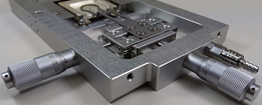
- Position samples anywhere within the sampling area for fast in situ adjustments
- Precisely align specific sample features in optical paths
- Consists of a thin metal square or circular looped arm that extends over part of the sample area
- Arm is controlled externally by Vernier dials with 10mm of travel in two dimensions
- Greater flexibility, sample area accessibility, and precision control in moving the sample inside the chamber than in moving the stage on the microscope
- XY positioning is optimal for use with a rotational stage on a polarizing microscope due to the directional nature of polarization
FRAME & OUTER COVER
- Solid lightweight aluminum construction for some models
- Cover edge slides easily under beveled lip in the frame and cover is held securely in place with spring-loaded screws, for some models

CHAMBER HEIGHT & INNER COVER
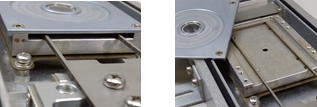
- The chamber height is the distance between the top surface of the thermal block and the bottom surface of the outer cover, when inner cover is present
- This distance is minimized in design to allow for just enough height for intended samples (slides, slipcovers, wafer pieces, and any clamps or probes) and to decrease the minimum objective working distance
- Some stages feature a removable inner cover with a separate built-in window
- The inner cover significantly reduces vertical temperature gradients
SAMPLE LOADING
- Some models feature convenient sample side loading and unloading without opening stage covers
- Some models feature covers configurable to swing or pivot from any single corner for quick sample access
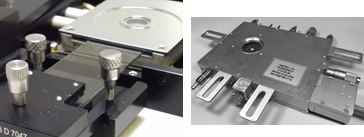
MOUNTING
- Various mounting adaptors are available for all most all microscope models, or other instruments
- Vertical mounting is possible for almost all Instec stages, for horizontal beam access to the samples
GAS PURGING & VACUUM PORTS

- Some models feature gas purging capability
- Either port can be input or output for purging gas flow
- Some models feature vacuum capability
- Two ports allow one to be used for pumping and the other for a pressure gauge
FRAME COOLING
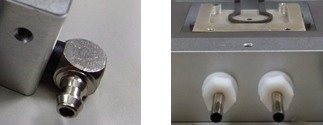
- For some models, the integrated frame cooling dissipates heat and allows the frame to remain cool or warm to the touch
LIQUID NITROGEN COOLING
- Integrated liquid nitrogen cooling on some models allows precision thermal control down to -190C
- Different LN2 pump options are available
- Different Dewar sizes are available
THERMAL CONTROL, mk2000 Temperature Controller
STATIC OPERATION
- In normal operation the controller uses a PID algorithm to adjust heating power and cooling pumping flow to maintain the current temperature
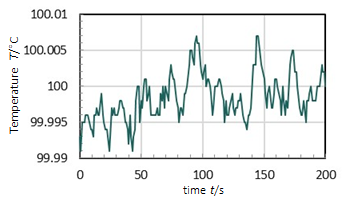
RAMP OPERATION
- To ramp to a user-defined target temperature TT at a specified ramp rate R from a current temperature TC, the controller calculates a target temperature profile
- The controller then adjusts the heating power and cooling pumping flow to achieve the target temperature profile
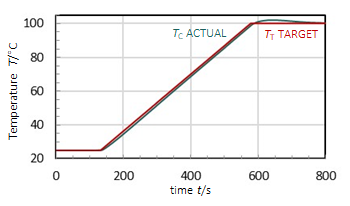
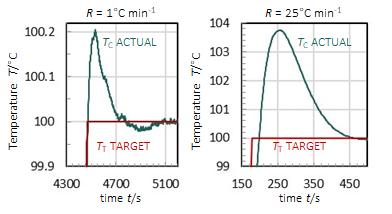
- In a real system, the wiring, a sample on the heating block, and the surrounding atmosphere are thermal loads that dissipate power
- Electrical and thermal inertia can result in short time delays in electrical and thermal responses and in achieving stability in the target temperature
- Faster ramp rates can result in greater overshooting of target temperatures because of thermal inertia
- Overshoot and delay can never be eliminated fully in a real system, but can be minimized by using the slowest ramp rate possible for the process
SAMPLE COOLING
- To achieve below ambient temperatures an active cooling system is necessary: a recirculating water chiller or a liquid nitrogen cooling system
- Active cooling has the advantage over passive cooling to allow fast experiment cycling
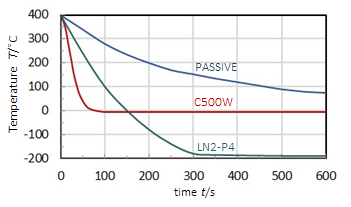
FRAME COOLING SYSTEMS
- Frame cooling option with recirculating chiller allows thermal control of frame independent of sample thermal block
- Keeps frame safe to touch and prevents frost buildup on windows
LIQUID NITROGEN COOLING SYSTEMS
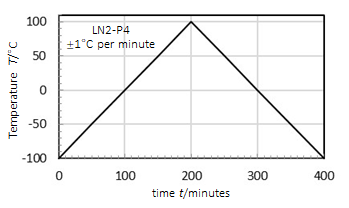
- Liquid nitrogen systems provide sample cooling to as low as -190°C depending on pump power and thermal block size
- Systems consist of a pump, a Dewar, a lid with a stoppered port for refilling during operation, and connecting tubing
- Three liquid nitrogen pump output options available, LN2-P2, LN2-P4, and LN2-P8, which suction liquid nitrogen through the equipment and are controlled by the mK2000
- Three Dewar sizes, 2 L, 10 L, and 30 L, with easy refillable lid options to control liquid nitrogen supply to instruments
- Integrates with mK2000 PID controller with ±0.1% resolution
LIQUID NITROGEN SYSTEM MINIMUM TEMPERATURES |
|||
|
LN2-P2
|
LN2-P4
|
LN2-P8
|
|
|
CHUCKS & PLATES
|
|||
|
-40°C |
-60°C |
-120°C |
|
-20°C |
-40°C |
-100°C |
|
NA |
-30°C |
-80°C |
|
NA |
-20°C |
-60°C |
|
-120°C |
-170°C |
-190°C |
